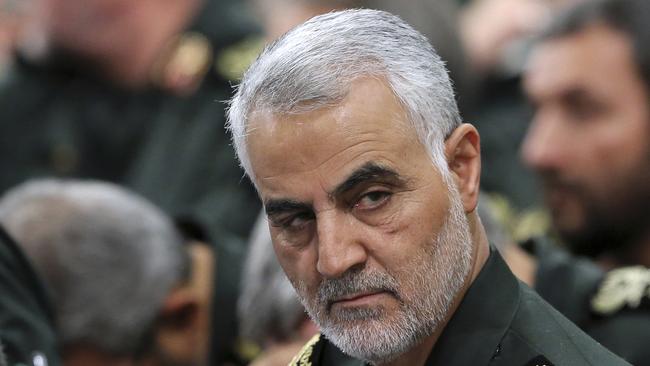Donald Trump puts US back into Middle East mire with Soleimani killing
The drone strike that killed the Iranian Quds Force commander marks a pivot toward direct confrontation with Iran.

The US drone strike that killed the Iranian Quds Force commander marks a pivot toward direct confrontation with Iran, further entangling the US in the Middle East after years of trying to avoid a major conflict.
Since taking office, President Donald Trump has made a priority of winding up the fight against Islamic State militants and reducing the US military footprint in the Middle East. The Trump administration was determined to roll back Iranian power and stop its nuclear program by tightening economic sanctions — not through military power.
With Islamic State seemingly routed in Iraq and Syria, and Tehran lashing out in the face of a deteriorating economy, the US and Iran have entered a new phase as they vie to shape the ragged peace in an unsteady part of the world.
See-sawing tensions in recent months rose in the past few weeks, with Iranian-backed militias trying to harass US forces by stepping up rocket attacks against bases in Iraq. US Secretary of State Mike Pompeo warned last month that should harm come to any American the US would respond.
On December 27 the administration’s red line was crossed when a rocket attack carried out by the Iranian-backed Kataib Hezbollah militia killed a US contractor at a base near Kirkuk.
That set in motion a spiral of violence that ultimately led to the targeting of Major-General Qassem Soleimani, the commander of the Iranian Revolutionary Guard’s overseas wing, and Iraqi paramilitary military leader Abu Mahdi al-Mohandes on a road leading from Baghdad airport.
“Ever since the US official was killed in indirect fire in Iraq, (Trump) said enough is enough,” says a senior White House official.
In killing the Iranian commander, the Trump administration is gambling that it can weaken Iran’s regional influence, possibly forcing Tehran to negotiate. Such an outcome could boost Trump as he faces an impeachment trial and gears up for re-election.
Critics say the killing of Soleimani is more likely to inflame tensions, generating reprisals from Iran and potentially miring the US further in the region.
“The level of unpredictability going forward is very concerning to me,” says Andy Kim, who was the Iraq director at the National Security Council under President Barack Obama. He says the Obama administration considered killing Soleimani but never went through with it because of concerns about a backlash.
US defence officials say Soleimani was behind the dozen or so rocket attacks that showered Iraqi bases since October, including the strike that killed the American contractor, who was working as a linguist. The Iranian commander was involved in plotting future attacks on Americans in Lebanon, Syria and Iraq, having recently visited those places as part of the planning, the officials said. There was “clear, unambiguous intelligence indicating a significant campaign of violence against the United States in the days, weeks and months” ahead, said General Mark Milley, chairman of the Joint Chiefs of Staff.
A State Department official adds: “These were attacks targeting American diplomats, American military personnel and facilities that house Americans.”
After the death of the contractor, on December 27, the US responded with airstrikes against compounds of the Iranian-backed Kataib Hezbollah paramilitary group in Iraq and Syria that the group says killed 27 people. That weekend, Trump also authorised the use of military force on Soleimani, US officials say.
Milley, US Defence Secretary Mark Esper and Pompeo discussed the strike with Trump. Senior officials concluded “there was a reasonable chance” the strike wouldn’t spark a war and would instead empower moderates in Iran, a White House official says.
Talks on targeting Soleimani also “went through a legal review” to determine whether it qualified as self-defence, the official says.
Five days later, Soleimani flew to Baghdad, becoming what one defence official describes as a “target of opportunity”. The airport road Soleimani and Mohandes took has few exit ramps and is lined with high walls, making it an optimum location for a targeted killing.
As Soleimani started out on that road an unmanned aerial drone dropped ordnance on the convoy, the defence officials say.
Getting Iran to refrain from reprisals is unlikely, experts say. “Nobody in the administration thinks that is going to happen,” says Kirsten Fontenrose of the Atlantic Council foreign policy think tank, who left Trump’s NSC in November 2018. After Soleimani’s death, Iran’s leaders named a replacement and vowed retaliation.
“Soleimani was iconic,” tweeted Norman Roule, a former CIA official on the Middle East. “He managed militias & terrorists. Neither will go away w his death. He will be replaced by others albeit w less experience & stature.”
Iran has a variety of options to strike back. The 5000 US troops in Iraq are part of an array of forces numbering 80,000 throughout the region at bases and at sea. US officials said some 3500 troops from the 82nd Airborne Division would be sent to Kuwait.
The region’s oil shipping and infrastructure remain a vulnerability and have been the targets of earlier skirmishes. Iranian forces could seed the Persian Gulf with mines and fire missiles at US bases, oilfields and desalination plants in the Arabian peninsula.
If it is looking to respond quickly, Iran could use the militia forces it backs in Iraq and elsewhere to mount rocket strikes and other attacks against US troops. Mounting cyberattacks against US businesses and institutions, experts say, is also an option.
Additional reporting: Vivian Salama
The Wall Street Journal



To join the conversation, please log in. Don't have an account? Register
Join the conversation, you are commenting as Logout